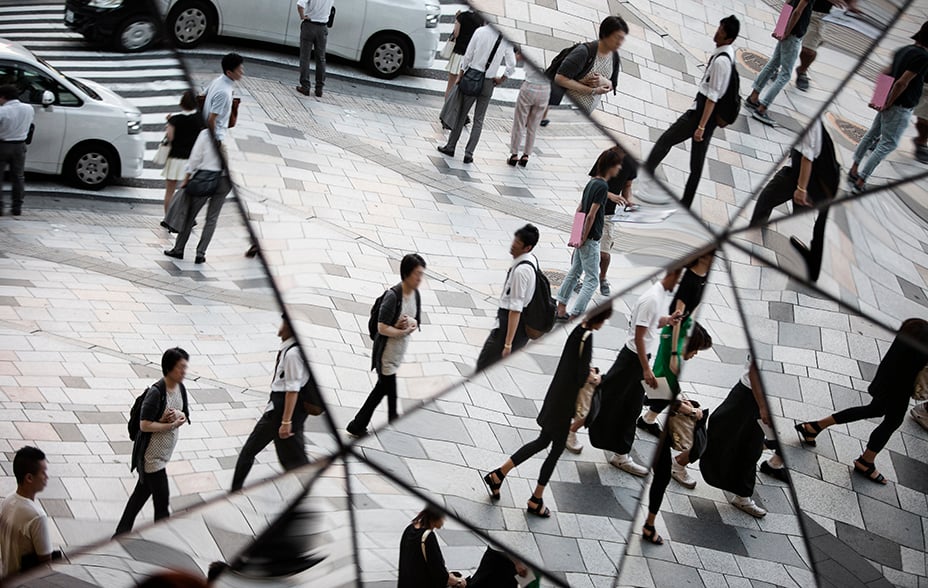
All investment strategies have the potential for profit and loss, capital is at risk. Past performance is not a guide to future returns.
My last visit to Japan ended as the last of the passengers and crew were disembarking from the Diamond Princess cruise ship in Yokohama in March 2020. So not returning until the restrictions were lifted after the seventh Covid-19 infection wave in September 2022 felt like a long absence.
It’s not that the Japan Team was out of touch during this period. We maintained roughly the same level of company contact via video call and benefited from some on-the-ground insight from our Tokyo-based researchers.
While we have adapted to the new forms of communication that enable easier and more immediate access (and greater proactivity by the companies), it’s nonetheless good to be back in Japan once more.
The following provides a brief overview of my reflections following my recent investment trip to Japan. The purpose of which was:
- to meet with senior executives at some of our major holdings
- to explore their specific business opportunities
- to examine their factory floors in person
Examples include Z Holdings’ potential in cashless payments platform PayPay, Recruits’ cloud-based solutions for smaller businesses and Rohm’s progress with leading-edge silicon carbide devices used in electric vehicles.
The note is not intended to be comprehensive but to highlight what has and hasn't changed in the past two years.
On the ground
The most immediate change was that in early September, people wore masks indoors and out, though this was no longer mandatory for the latter. Year to date, there have been fewer than a million visitors to Japan. In 2019, there were just under 32 million.
Whereas life feels back to normal in many western countries, Japan still has some way to go in its recovery. This is more pronounced the further you travel from Tokyo. Many I spoke to even noted a lingering reticence in rural villages to invite back friends and family from metropolitan areas.
If we can have one simple insight coming from outside Japan, it is the perspective of what eventual normality may look like. For example, Shiseido’s prestige skincare products are greatly affected by travel; consultancy businesses such as Nihon M&A are far more effective through face-to-face meetings between business owners and potential buyers.

Working it out
Among many companies, as elsewhere, work patterns have had to change. But as we’ve previously noted, disruption of patterns and traditional hierarchies are likely to have more fundamental ramifications in Japan than elsewhere.
For example, the acute and growing shortage of IT engineers has led to considerable changes in working practices, with greater inclusivity and many offices not starting work before 10am.
When I met Yuko Ichikawa, a former executive at Rakuten, the ecommerce company, and now the author of two books on changing corporate behaviour, she made two observations:
- The Japanese office was always structured as a place of oversight. It was difficult to reform companies within rigid hierarchies but removing these for a period has forced firms to adapt.
- Second, as the lifetime contract continues to fracture, accelerated by Covid, companies are trying to define their purpose more clearly. Likewise, employees are re-examining their purpose in a way which they wouldn’t have without the disruption of the past few years.
Ichikawa feels that this is making people more altruistic when considering their careers and believes it will support greater entrepreneurship. This is a global phenomenon, of course, but the implications feel profound in a more conventional country, where productivity remains relatively low.
Paying it forward
The most striking and evident change I saw from my visit in early 2020 was in payments. Card and contactless are ubiquitous, though the choice can still feel baffling and the processing far from seamless.
In 2013, the cashless percentage of payments was 13 per cent, mainly through credit cards, but in 2021 the rate had risen to just under one-third. The Ministry of Economy, Trade and Industry (METI) is promoting a figure of 40 per cent by 2025. However, the President of Z Holdings, the main shareholder of PayPay, Japan’s leading payment platform, reckons the number could be closer to 80 per cent by then. PayPay is already used by over 50 million people and has a two-thirds share of all QR-code payments.
A warm welcome
Nearly every company I asked to see in person accepted and made the CEO or President available for the meeting. Many of these were the founders of companies created in the aftermath of Japan’s Bubble Economy and corporate restructuring of the early 2000s.
We always look for alignment in our investments, most notably through insider ownership, but this can be double-edged at times of severe stress. Many of these founders have large stakes in their businesses, but at no stage was I asked about the market’s sudden reinterpretation of their business's value, despite (in some cases) extreme share price moves.
It was a timely reminder that Japanese capitalism is different, less overtly linked to wealth and, in times of severe stress, arguably longer term.

Resilience matters
If one word recurred more than any other during my meetings, it was ‘resilience’ in the context of business continuity planning. Companies have fundamentally rethought what this means during Covid and subsequent sporadic lockdowns.
In the past, resilience was all about having a lot of cash to anticipate the unforeseen or simply cover up for mistakes, but now this is more operational and strategic.
SMC, for example, only invested in logistic centres very recently. Previously, it shipped directly from its factories. Great companies can still find simple ways to be more efficient and resilient, and such planning no longer feels defensive, but about building long-term value.
Slow moving
Just under 10 per cent of Japan’s workforce is directly involved in car and manufacturing cars and car parts. The automotive industry has been integral to the nation’s industrial success over the past 50 years, but it is now at a major turning point.
About 40 per cent of cars sold in Japan are hybrid – nearly all full-hybrid – and less than 1 per cent are pure battery electric.
The reliance on standard hybrid as a transitional technology is immediately apparent, as is the absence of charging points: there are estimated to be just 8,000 fast chargers in Japan. Japan’s – and particularly Toyota’s – success with standard hybrids has created an unfavourable path dependency, harnessing existing skills, supply chains and infrastructure.
Japan seems poorly positioned when considering electric vehicles, which require not only a change in inputs but also knowledge, infrastructure and behaviour.
I met with DENSO, a major parts supplier to and affiliate of Toyota Motor. I sensed a growing and uncharacteristic frustration with the parent’s transition. It is even working to a different electric vehicle (EV) trajectory.
We have been reflecting our longer-term concern in our car-related holdings. There is, however, a wider concern over the economic impact, should the industry be slow to adapt. We can draw analogies with the consumer electronics industry in the 1990s and early 2000s.
On principle
ESG is becoming a more common part of the vernacular in Japan. Initially, it was regarded an external imposition, but now companies appear quite comfortable with the narrative even without their own term for it.
As a team, we have explored some of the more traditional Japanese approaches to corporate social responsibility and ESG to learn if a different understanding could be applied or even encouraged:
- sanpo yoshi is a 400-year-old merchant tradition that emphasised the three-way satisfaction of buyer, seller and society
- Rongo to Soroban (literally, the Analects of Confucius and abacus) is the influential early 20th-century work of Eiichi Shibusawa, founder of Japan’s first bank, who believed that in business you need to maintain a balance between economics and morality
Neither approach seems to match the current tenor and companies’ willingness to engage on governance matters. Even Keidanren, the Japan Business Federation, has weighed into the debate, advocating that Japanese companies disclose impact KPIs and use purpose as a starting point for dialogue with shareholders.
Japan’s willingness to listen and humility to learn may become a collective edge. Our governance engagement over the past few years, increasingly leads us to this view.
For example, our meeting with the tyre-maker Bridgestone underlined the opportunity for EV brand-building and the benefit of efforts to promote a more circular economy around tyre re-tread, where it is already the global market leader.

A lot to learn
We are trying to deepen our connections with Japanese academia. We’ve tried this before but have been frustrated in our efforts for a variety of reasons. Japan feels like a valuable, untapped source of insight and is increasingly looking to solve fundamental, societal issues in an innovative, cross-disciplinary manner.
I met with two research units within Tokyo and Kyoto Universities to discuss possible future learning.
The Tokyo Institute for Future Initiatives for example, is engaged in trying to solve some common issues. It aims to present a vision of a future society built on advanced technologies, while addressing fundamental, normative questions about our existence.
The Kyoto Institute for Integrated Cell-Material Science, which has produced a Nobel laureate in stem-cell research, integrates research in cell biology, materials science and chemistry to confront myriad problems in health, environmental and energy sectors.
Another area of potential interest is robotics, which has obvious links to some of our investments.
A good place to be
The final observation from my trip is that the positive backdrop for continued, usually digitally-enabled disruption remains. Most of our investments continue to enjoy high growth, be it in fintech, cloud migration, ecommerce, healthcare or IT infrastructure.
This still feels like a huge opportunity, particularly after share price corrections. The confidence was often palpable when meeting in person. There’s a saying that ’distance lends perspective’, and returning to Japan after a two-and-a-half-year absence gave my colleagues and me considerable grounds for enthusiasm.
Risk factors
This communication was produced and approved in November 2022 and has not been updated subsequently. It represents views held at the time of writing and may not reflect current thinking.
All investment strategies have the potential for profit and loss, your or your clients’ capital may be at risk. Past performance is not a guide to future returns.
This communication contains information on investments which does not constitute independent research. Accordingly, it is not subject to the protections afforded to independent research, and Baillie Gifford and its staff may have dealt in the investments concerned.
Baillie Gifford & Co Limited is wholly owned by Baillie Gifford & Co. Both companies are authorised and regulated by the Financial Conduct Authority and are based at: Calton Square, 1 Greenside Row, Edinburgh EH1 3AN.
All information is sourced from Baillie Gifford & Co and is current unless otherwise stated.
Ref: 28507 10017089






